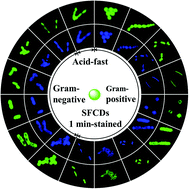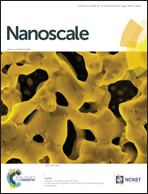A self-quenching-resistant carbon nanodot powder with multicolored solid-state fluorescence for ultra-fast staining of various representative bacterial species within one minute†
Abstract
In this study, we prepared self-quenching-resistant solid-state fluorescent carbon nanodots (SFCDs) without any other solid matrices. The SFCDs were prepared using a one-step microwave synthesis method through precise control of the heating power and time. The resulting SFCD powder showed excitation-dependent emission behavior with a maximum fluorescence quantum yield of 40%. The multicolored SFCDs were successfully used as fluorescent agents for rapid staining of 14 representative bacterial species, including Gram-negative, Gram-positive, and acid-fast bacteria. Moreover, some pathogenic bacteria, including Bacillus anthracis (vegetative cells and endospores), Yersinia pestis, Vibrio cholera O1, Listeria monocytogenes, Neisseria meningitidis, and Klebsiella pneumoniae, could all be stained within just 1 min by the smear staining method without any incubation, which was also applicable by using the liquid incubation method. Moreover, excellent staining quality, superior resistance to photobleaching, high stability in solutions of different pH values, and low toxicity were also demonstrated.



 Please wait while we load your content...
Please wait while we load your content...